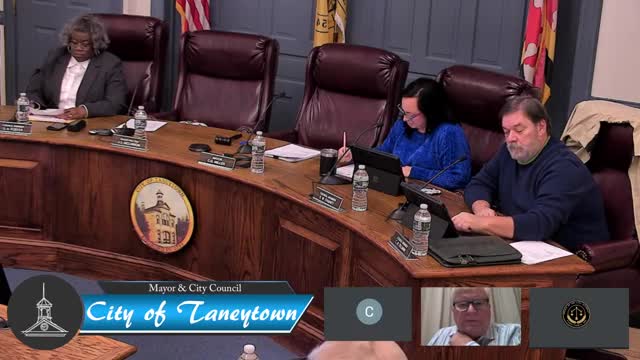Taneytown council directs staff to draft enabling ordinance for automated speed cameras after vendor briefing
January 13, 2025 | Taneytown, Carroll County, Maryland
This article was created by AI summarizing key points discussed. AI makes mistakes, so for full details and context, please refer to the video of the full meeting. Please report any errors so we can fix them. Report an error »

The Taneytown City Council directed staff to prepare enabling legislation for automated speed-enforcement cameras after a presentation by a private vendor and a short council debate.
Mike Phelan, director of strategic accounts for Ultimate (a speed- and red-light enforcement vendor), told the council the company operates in roughly 72 jurisdictions and that its program is “a 100% violator funded” service, meaning no up-front cost for equipment or installation to the municipality. He said his firm’s short speed study on the stretch of Travanian Road captured about 277 violations at the vendor’s reporting threshold of 12 mph over the posted 25 mph limit during sample days. “The base fine is $40 set by the state,” Phelan said, describing how Maryland processes citations and noting eligible delinquent Maryland registrations can be flagged by MVA if fines are not paid.
City Attorney Jay Gullo told the council the town must adopt an ordinance and execute a vendor contract that satisfies state statutory requirements before cameras can be used. “There is a procedure. You can’t just do this. You’re gonna have to pass an ordinance, that’s pretty specified by the state as to what it contains. And then you have to execute a contract with the vendor,” Gullo said.
Council debate mixed safety concerns and civil-liberty reservations. Councilman Tillman said he could not support moving forward based on the data presented: “Personally speaking, I don’t, I don’t think I can support those with the numbers that I saw today … I just don’t think the juice is worth the squeeze, personally.” Other council members said the study and anecdotal complaints about speeding — particularly on a stretch used by pedestrians and students and where police already record enforcement activity — weighed in favor of pursuing the ordinance.
After a show of hands, Mayor Pro Tem announced the tally as 3 in favor and 1 opposed and directed staff to begin drafting the enabling ordinance and to work with the city attorney. The council did not adopt any ordinance or contract at the meeting; the action was a direction to prepare legislation and proceed with the next steps.
Phelan described typical operational details during his presentation: the vendor’s cameras are generally calibrated daily and remotely monitored; sample implementation timelines run about five months from contract signing to full deployment, though jurisdictions sometimes shorten that; hours permitted under Maryland law are typically 6 a.m. to 8 p.m.; and the vendor recommended prominent signage at camera locations. He also noted portable trailer units are available but said a fixed pole-mounted solution was likely more appropriate for the studied location.
The council’s next step is a draft ordinance and an eventual decision whether to advertise and enter a vendor contract; no contract award or detail of a procurement process was approved at this meeting.
Mike Phelan, director of strategic accounts for Ultimate (a speed- and red-light enforcement vendor), told the council the company operates in roughly 72 jurisdictions and that its program is “a 100% violator funded” service, meaning no up-front cost for equipment or installation to the municipality. He said his firm’s short speed study on the stretch of Travanian Road captured about 277 violations at the vendor’s reporting threshold of 12 mph over the posted 25 mph limit during sample days. “The base fine is $40 set by the state,” Phelan said, describing how Maryland processes citations and noting eligible delinquent Maryland registrations can be flagged by MVA if fines are not paid.
City Attorney Jay Gullo told the council the town must adopt an ordinance and execute a vendor contract that satisfies state statutory requirements before cameras can be used. “There is a procedure. You can’t just do this. You’re gonna have to pass an ordinance, that’s pretty specified by the state as to what it contains. And then you have to execute a contract with the vendor,” Gullo said.
Council debate mixed safety concerns and civil-liberty reservations. Councilman Tillman said he could not support moving forward based on the data presented: “Personally speaking, I don’t, I don’t think I can support those with the numbers that I saw today … I just don’t think the juice is worth the squeeze, personally.” Other council members said the study and anecdotal complaints about speeding — particularly on a stretch used by pedestrians and students and where police already record enforcement activity — weighed in favor of pursuing the ordinance.
After a show of hands, Mayor Pro Tem announced the tally as 3 in favor and 1 opposed and directed staff to begin drafting the enabling ordinance and to work with the city attorney. The council did not adopt any ordinance or contract at the meeting; the action was a direction to prepare legislation and proceed with the next steps.
Phelan described typical operational details during his presentation: the vendor’s cameras are generally calibrated daily and remotely monitored; sample implementation timelines run about five months from contract signing to full deployment, though jurisdictions sometimes shorten that; hours permitted under Maryland law are typically 6 a.m. to 8 p.m.; and the vendor recommended prominent signage at camera locations. He also noted portable trailer units are available but said a fixed pole-mounted solution was likely more appropriate for the studied location.
The council’s next step is a draft ordinance and an eventual decision whether to advertise and enter a vendor contract; no contract award or detail of a procurement process was approved at this meeting.
View full meeting
This article is based on a recent meeting—watch the full video and explore the complete transcript for deeper insights into the discussion.
View full meeting
